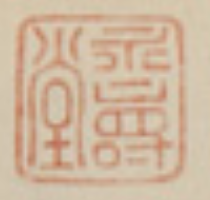
Portrait by Utagawa Toyokuni I commemorating 71st year of Nishimuraya Yohachi, c. 1799
Nishimuraya Yohachi (dates unknown)[1] was one of the leading publishers of woodblock prints in late 18th-century Japan.[2] He founded the Nishimuraya Yohachi publishing house, also known as Nishiyo (西与),[3] which operated in Nihonbashi's Bakurochō Nichōme under the shop name Eijudō. The firm's exact dates are unclear, but many art historians date its activity to between c. 1751 and 1860.[4][5]
According to Andreas Marks, Nishimuraya is "one of the most important publishers in the history of prints and may be the publisher with the biggest output over time," attributing his success to "engaging the best artists and providing a broad range of prints to satisfy the public's interest."[6] One of the press' most significant products was Hokusai's famous Thirty-six Views of Mount Fuji, which appeared between c. 1830 and 1833[7] and the first two volumes of his exquisite 100 Views of Mount Fuji ehon in 1834 and 1835.[8] Nishimuraya Yohachi also published prints by Eishi, Kuniyasu, Toyokuni I and Kunisada.[9]
Nishimuraya is immortalized in the 1787 print Eijudō Hibino at Seventy-one by Utagawa Toyokuni I.[10]

He is known to have been a member of the Fuji-kō, an Edo period cult centred around Mount Fuji.[11] Founded by an ascetic named Hasegawa Kakugyō (1541–1646),[12] the cult venerated the mountain as a female deity, and encouraged its members to climb it.[13] In doing so they would be reborn, "purified and... able to find happiness."[14] The cult waned in the Meiji period and although it persists to this day it has been subsumed into Shintō sects.[15] The publisher's association with the Fuji-kō gives clues not only to imagery in his portrait by Utagawa, but also to his eagerness to participate in the production of Hokusai's various works celebrating Mount Fuji.
- ^ "Mr. Edmonds, the cataloguer at Sotheby’s before the Second World War, seems to have been the first to suggest, in a catalogue of 1912, that Eijudō was born in 1729 and would therefore be seventy-one by Japanese reckoning, in 1799. 1799 is a plausible date for the print, but Edmunds cited no source for his information about the year of Eijudō's birth, and no recent Japanese scholar has proposed a date." (Museum Angewandte Kunst)
- ^ Newland 2003, 475
- ^ Newland 2003, 175
- ^ Pushkin State Museum; Japanese Prints
- ^ Newland is less precise, describing Nishimuraya as active from the "mid-eighteenth to mid-nineteenth century (2003, 475); Machotka chooses the period c. 1789–1830 (2009, 64), and Volker insists on 1738-1818 (1949, 20).
- ^ Marks
- ^ Newland 2003, 206
- ^ Hillier & Smith
- ^ Japanese Prints
- ^ Part of the Gerhard Pulverer Collection currently housed at the Smithsonian's Freer Gallery.
- ^ Honolulu Museum
- ^ Melton 2008, 231
- ^ Yamaguchi
- ^ Yamaguchi
- ^ Melton 2008, 231